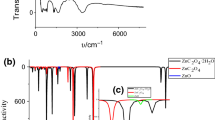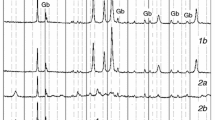Abstract
The copper(II) oxalate was synthesized, characterized using FT-IR and scanning electron microscopy and its non-isothermal decomposition was studied by differential scanning calorimetric at different heating rates. The kinetics of the thermal decomposition was investigated using different isoconversional and maximum rate (peak) methods viz. Kissinger–Akahira–Sunose (KAS), Tang, Starink1.95, Starink1.92, Flynn–Wall–Ozawa (FWO) and Bosewell. The activation energy values obtained from isoconversional methods of FWO and Bosewell are 0.9 and 3.0 %, respectively, higher than that obtained from other methods. The variation of activation energy, E α with conversion function, α, established using these different methods were found to be similar. Compared to the FWO method, the KAS method offers a significant improvement in the accuracy of the E a values. All but the Bosewell maximum rate (peak) methods yielded consistent values of E α (~137 kJ mol−1); however, the complexity of the thermal decomposition reaction can be identified only through isoconversional methods.






Similar content being viewed by others
References
L’vov BV. Kinetics and mechanism of thermal decomposition of nickel, manganese, silver, mercury and lead oxalates. Thermochim Acta. 2000;364:99–109.
Murhty HSG, Rao MS, Kutty TRN. Thermal decomposition of titanyl oxalates—II: kinetics of decomposition of barium titanyl oxalate. J Inorg Nucl Chem. 1975;7:1875–8.
Patra BS, Otta S, Bhattamisra SD. A kinetic and mechanistic study of thermal decomposition of strontium titanyl oxalate. Thermochim Acta. 2006;441:84–8.
Padmanabhan VM, Saraiya SC, Sundaram AK. Thermal decomposition of some oxalates. J Inorg Nucl Chem. 1960;12:356–9.
Krishnamurty KV, Harris GM. The chemistry of the metal oxalato complexes. Chem Rev. 1961;61:213–41.
Dollimore D, Nicholson D. The thermal decomposition of oxalates. Part I. The variation of surface area with the temperature of treatment in air. J Chem Soc. 1962;960–5.
Dollimore D, Griffiths DL, Nicholson D. The thermal decomposition of oxalates. Part II. Thermogravimetric analysis of various oxalates in air and in nitrogen. J Chem Soc. 1963;2617–23.
Dollimore D. The thermal decomposition of oxalates: a review. Thermochim Acta. 1987;117:331–63.
Cetisli H, Cilgy GK, Donat R. Thermal and kinetic analysis of uranium salts Part 1. Uranium (VI) oxalate hydrates. J Therm Anal Calorim. 2012;108:1213–22.
Lee S, Choi US, Li S, Eastman JA. Measuring thermal conductivity of fluids containing oxide nanoparticles. J Heat Trans. 1999;121:280–9.
Broadbent D, Dollimore J, Dollimore D, Evans TA. Kinetic study on the thermal decomposition of copper(II) oxalate. Faraday Trans. 1991;87:161–6.
Dollimore D, Evans TA, Lee YF. Thermal decomposition of oxalates Part 25. The effect of sample preparation and environmental atmosphere on the thermal stability of copper(II) oxalate. Thermochim Acta. 1992;194:215–20.
Mohamed MA, Galwey AK. A kinetic and mechanistic study of the thermal decomposition of copper(II) oxalate. Thermochim Acta. 1993;217:263–76.
Galwey AK, Mohamed MA. A kinetic and mechanistic study of the thermal decomposition of copper(II) mallitate. Thermochim Acta. 1994;239:211–24.
Al-Newaiser FA, Al-Thabaiti SA, Al-Youbi AO, Obaid AY, Gabal MA. Thermal decomposition kinetics of strontium oxalate. Chem Papers. 2007;61:370–5.
Mohamed MA, Galwey AK, Halawy SA. A comparative study of the thermal reactivities of some transition metal oxalates in selected atmospheres. Thermochim Acta. 2005;429:57–72.
Mohamed MA, Galwey AK, Halawy SA. Kinetic and thermodynamic studies of the non-isothermal decomposition of anhydrous copper(II) formate in different gas atmospheres. Thermochim Acta. 2004;411:13–20.
Coetzee A, Eve DJ, Brown ME, Strydom CA. Kinetics of the thermal dehydrations and decompositions of some mixed metal oxalates. J Therm Anal. 1994;41:357–85.
Lamprecht E, Watkins GM, Brown ME. The thermal decomposition of copper(II) oxalate revisited. Thermochim Acta. 2006;446:91–100.
Vyazovkin S, Sbirrazzuoli N. Isoconversional analysis of the non-isothermal crystallization of a polymer melt. Macromol Rapid Commun. 2002;23:766–70.
Vyazovkin S, Sbirrazzuoli N. Estimating the activation energy for non-isothermal crystallization of polymer melts. J Therm Anal Calorim. 2003;72:681–6.
Starink MJ. The determination of activation energy from linear heating rate experiments: a comparison of the accuracy of isoconversion methods. Thermochim Acta. 2003;404:163–76.
Vyazovkin S, Sbirrazzuoli N. Isoconversional Approach to Evaluating the Hoffman-Lauritzen Parameters (U* and Kg) from the overall rates of non-isothermal crystallization. Macromol Rapid Commun. 2004;25:733–8.
Khawam A, Flanagan DR. Role of isoconversional methods in varying activation energies of solid-state kinetics: II. Non-isothermal kinetic studies. Thermochim Acta. 2005;436:101–12.
Vyazovkin S. Model-free kinetics, staying free of multiplying entities without necessity. J Therm Anal Calorim. 2006;83:45–51.
Vyazovkin S, Sbirrazzuoli N. Isoconversional kinetic analysis of thermally stimulated processes in polymers. Macromol Rapid Commun. 2006;27:1515–32.
Starink MJ. Activation energy determination for linear heating experiments: deviations due to neglecting the low temperature end of the temperature integral. J Mater Sci. 2007;42:483–9.
Simon P. Isoconversional methods. J Therm Anal Calorim. 2004;76:123–32.
Joraid AA, Abu-Sehly AA, El-Oyoun MA, Alamri SN. Non-isothermal crystallization kinetics of amorphous Te51.3As45.7Cu3. Thermochim Acta. 2008;470:98–104.
Akahira T, Sunose T. Trans joint convention of four electrical Institutes, paper no. 246, Research Report, Chiba Institute of Technology. Sci Technol. 1969;1971(16):22–31.
Kissinger HE. Reaction kinetics in differential thermal analysis. Anal Chem. 1957;29:1702–6.
Aboulkas A, El Harfi K, El Bouadili A, Benchanaa M, Mokhlisse A, Outzourit A. Kinetics of co-pyrolysis of Tarfaya (Morocco) oil shale with high-density polyethylene. Oil Shale. 2007;24:15–33.
Murray P, White J. Kinetics of the thermal dehydration of clays IV. Thermal analysis of the clay minerals. Trans Brit Ceram Soc. 1955;54:204–38.
Tang W, Liu Y, Zhang H, Wang C. New approximate formula for Arrhenius temperature integral. Thermochim Acta. 2003;408:39–43.
Starink MJ. A new method for the derivation of activation energies from experiments performed at constant heating rate. Thermochim Acta. 1996;288:97–104.
Flynn J, Wall LA. A quick, direct method for the determination of activation energy from thermogravimetric data. Polym Lett. 1966;4:323–8.
Ozawa T. A new method of analyzing thermogravimetric data. Bull Chem Soc Jpn. 1965;38:1881–6.
Doyle C. Kinetic analysis of thermogravimetric data. J Appl Polym Sci. 1961;5:285–92.
Boswell PG. On the calculation of activation energies using a modified Kissinger method. J Therm Anal. 1980;18:353–8.
Kissinger HE. Variation of peak temperature with heating rate in differential thermal analysis. J Res Natl Bur Stand. 1956;57:217–21.
Vyazovkin S, Burnham AK, Criado JM, Pérez-Maqueda LA, Popescu C, Sbirrazzuoli N. ICTAC Kinetics committee recommendations for performing kinetic computations on thermal analysis data-review. Thermochim Acta. 2011;520:1–19.
Rao CNR. Chemical applications of infra red spectroscopy. New York: Academic Press; 1963. p. 365.
Starink MJ, Van Mourik P. Cooling and heating rate dependence of precipitation in an Al–Cu alloy. Mater Sci Eng A. 1992;156:183–94.
Starink MJ. On the applicability of isoconversion methods for obtaining the activation energy of reactions within a temperature dependent equilibrium state. J Mater Sci. 1997;32:6505–12.
Shah HV, Babb DA, Smith DW Jr. Bergman cyclopolymerization kinetics of bis-ortho-diynylarenes to polynaphthalene networks. A comparison of calorimetric method. Polymer. 2000;41:4415–22.
Nakamoto K, Fujita J, Tanaka C, Kobayashi M. Infrared spectra of metallic complexes. IV. Comparison of the infrared spectra of unidentate and bidentate metallic complexes. J Am Chem Soc. 1957;79:4904–8.
Schmelz MJ, Miyazawa T, Mizushima S, Lane TJ, Quagliano JV. Infra red absorption spectra of inorganic co-ordination complexes—IX Infra red spectra of oxalate complexes. Spectrochim Acta. 1957;9:51–8.
Fujita J, Nakamoto K, Kobayashi M. Infrared spectra of metallic complexes. III. The infrared spectra of metallic oxalates. J Phys Chem. 1957;61:1014–5.
Fan Y, Zhang C, Zhan J, Wu J, Yang P. Thermodynamic equilibrium calculation on preparation of copper oxalate precursor powder. Trans Nonferr Met Soc. 2010;20:165–70.
Randhawa BS, Kaur M. A comparative study on the thermal decomposition of some transition metal maleates and fumarates. J Therm Anal Calorim. 2007;89:251–5.
Miller TW. Use of TG/FT-IR in material characterization. J Therm Anal Calorim. 2011;106:249–54.
Birzescu M, Niculescu M, Dumitru R, Budrugeac P, Segal E. Copper(II) oxalate obtained through the reaction of 1,2-ethanediol with Cu(NO3) ·2 3H2O: structural investigations and thermal analysis. J Therm Anal Calorim. 2008;94:297–303.
Khadikar PV. Structure and thermal characterization of tris-thallium(III) glycollate. J Therm Anal. 1987;32:737–48.
Nagase K, Sato K, Tanaka N. Thermal dehydration and decomposition reactions of bivalent metal oxalates in the solid state. Bull Chem Soc Jpn. 1975;48:439–45.
Clarke RM, Williams IR. Moolooite, a naturally occurring hydrated copper oxalate from Western Australia. Mineral Mag. 1986;50:295–8.
Wu X, Zhou K, Wu W, Cui X, Li Y. Magnetic properties of nanocrystalline CuFe2O4 and kinetics of thermal decomposition of precursor. J Therm Anal Calorim. 2013;111:9–16.
Mehta SK, Kaur R. Thermal analysis, decomposition kinetics, and molecular modeling of transition metal (Fe, Co) surfactant complexes. J Therm Anal Calorim. 2013;. doi:10.1007/s10973-013-3244-7.
Author information
Authors and Affiliations
Corresponding author
Rights and permissions
About this article
Cite this article
Muraleedharan, K., Kripa, S. DSC kinetics of the thermal decomposition of copper(II) oxalate by isoconversional and maximum rate (peak) methods. J Therm Anal Calorim 115, 1969–1978 (2014). https://doi.org/10.1007/s10973-013-3366-y
Received:
Accepted:
Published:
Issue Date:
DOI: https://doi.org/10.1007/s10973-013-3366-y




